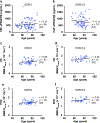Blood-brain barrier breakdown is an early biomarker of human cognitive dysfunction
- PMID: 30643288
- PMCID: PMC6367058
- DOI: 10.1038/s41591-018-0297-y
Blood-brain barrier breakdown is an early biomarker of human cognitive dysfunction
Abstract
Vascular contributions to cognitive impairment are increasingly recognized1-5 as shown by neuropathological6,7, neuroimaging4,8-11, and cerebrospinal fluid biomarker4,12 studies. Moreover, small vessel disease of the brain has been estimated to contribute to approximately 50% of all dementias worldwide, including those caused by Alzheimer's disease (AD)3,4,13. Vascular changes in AD have been typically attributed to the vasoactive and/or vasculotoxic effects of amyloid-β (Aβ)3,11,14, and more recently tau15. Animal studies suggest that Aβ and tau lead to blood vessel abnormalities and blood-brain barrier (BBB) breakdown14-16. Although neurovascular dysfunction3,11 and BBB breakdown develop early in AD1,4,5,8-10,12,13, how they relate to changes in the AD classical biomarkers Aβ and tau, which also develop before dementia17, remains unknown. To address this question, we studied brain capillary damage using a novel cerebrospinal fluid biomarker of BBB-associated capillary mural cell pericyte, soluble platelet-derived growth factor receptor-β8,18, and regional BBB permeability using dynamic contrast-enhanced magnetic resonance imaging8-10. Our data show that individuals with early cognitive dysfunction develop brain capillary damage and BBB breakdown in the hippocampus irrespective of Alzheimer's Aβ and/or tau biomarker changes, suggesting that BBB breakdown is an early biomarker of human cognitive dysfunction independent of Aβ and tau.
Conflict of interest statement
COMPETING INTERESTS STATEMENT:
The authors declare no competing financial interests.
Figures














Comment in
-
Biomarkers for Alzheimer's disease beyond amyloid and tau.Nat Med. 2019 Feb;25(2):201-203. doi: 10.1038/s41591-019-0348-z. Nat Med. 2019. PMID: 30728536 No abstract available.
References
Publication types
MeSH terms
Substances
Grants and funding
- R01 AG023084/AG/NIA NIH HHS/United States
- RF1 AG039452/AG/NIA NIH HHS/United States
- R01 NS090904/NS/NINDS NIH HHS/United States
- R01 NS100459/NS/NINDS NIH HHS/United States
- R01 AG054434/AG/NIA NIH HHS/United States
- R01 AG055770/AG/NIA NIH HHS/United States
- R21 AG055034/AG/NIA NIH HHS/United States
- R00 AG058780/AG/NIA NIH HHS/United States
- P01 AG052350/AG/NIA NIH HHS/United States
- P50 AG005142/AG/NIA NIH HHS/United States
- R01 AG039452/AG/NIA NIH HHS/United States
- K99 AG058780/AG/NIA NIH HHS/United States
- P01 AG003991/AG/NIA NIH HHS/United States
- P50 AG005681/AG/NIA NIH HHS/United States
- P01 AG026276/AG/NIA NIH HHS/United States
- R01 NS034467/NS/NINDS NIH HHS/United States
LinkOut - more resources
Full Text Sources
Other Literature Sources
Medical

